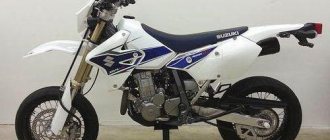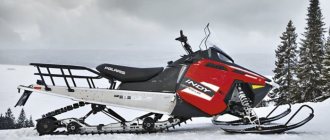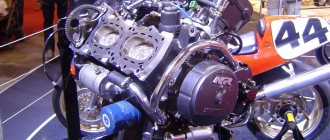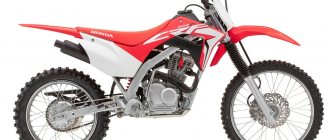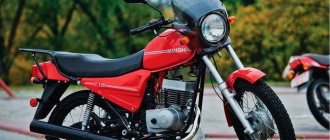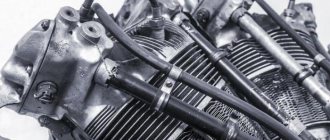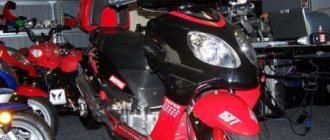| Honda CR125R (1998-1999) | Honda CR125R (2000-2001) | Honda CR125R (2002-2007) |
Model of a 2-stroke motocross motorcycle Honda CR125R
begins its history in 1974, when this model was first introduced to the market. Modern modifications of the Honda CR 125 R were produced from the 90s of the last century until 2007. Since 1998, these motorcycles received an aluminum frame, which was improved and made lighter in subsequent years.
A special feature of the Honda CR125R motorcycle is a 1-cylinder, 2-stroke, liquid-cooled engine producing 41 hp. power and 27 Nm of torque. The model also had modern sports suspensions, in particular, an inverted Kayaba fork, which had a full range of adjustments.
The “older” model is the Honda CR250R.
The main competitors of the Honda CR 125 R in the class:
- Suzuki RM 125
- Yamaha YZ 125
- Kawasaki KX 125
Appearance
Honda CR 125 is very similar to CR 85. Same frame color scheme: red, light gray and black. Except there's more black. Typical design, typical dimensions and fit - in a word, a classic cross-country bike. The only difference between it and modern models in this regard is that the CR 125 and its contemporaries once set a trend that motorcycle manufacturers still follow.
Like the CR 85, the plastic is cheap, but it doesn't feel like it's of poor quality. It’s just that more expensive motocross bikes have a plastic that is nicer to the touch and more pleasing to the experienced eye to look at. No more.
RECORDED: FULL TEST OF THE 2001 HONDA CR125
This is an archived MXA test from the November 2000 issue of Motocross Action Magazine. Get your MXA Subscription now
QUESTION ONE: IS THE '01 ENGINE FASTER THAN THE '00?
Yes, but what old CR125 Hobbyists want to know how the '01 compares to the class-leading CR125s of the early '90s? Very auspicious because, as with the 2001 CR250, Honda is actively trying to bring its engine back to the glory of the past.
QUESTION TWO: IS THE '01 ENGINE FASTER THAN THE 95'
This may seem like a strange question. Why would anyone compare a new bike to a six year old one? The reason is simple. Over the past couple of years, most race teams have been running '95 cylinders on their race bikes. So whether the 2001 is faster than the 1995 Honda engine is of utmost importance.
This? Undeniably yes. If you think Honda is making a big mistake by going back, you should prefer the 125, which is not competitive. In 2001, you don't have to break the old cylinder (if you can even find one).
QUESTION THREE: IS THE CR125 FASTER THAN THE YZ125?
No, but what is a bicycle? We can say this, Yamaha took a step back in 2001 when they went with the 38mm carburetor and Honda took three steps forward with revised transfer ports, power valves and intake boot. The YZ125 is still faster, but it takes a better rider to get it into the YZ's powerband and keep it there. The CR125 doesn't suffer from fast guy syndrome. Slow guys and fast guys alike appreciate the CR125's quick throttle response, mid-range grunt and top-end revs.
QUESTION FOUR: WHAT IS POWERBAND CR125?
How does a 2001 Honda CR125 engine work?
(1) If you bought a CR125 looking for a lower end, you've made a serious mistake. The CR125 has no bottom. Slowly applying the throttle will result in a funky, low-frequency exhaust note and nothing else. Plan to use a lot of grip to skip the bottom and get right to the middle if you want to go fast on the CR125.
(2) The mid-range is where the CR125 shines. Not only is it wide and strong, but when the powerband comes alive, it does its best in the midrange.
(3) The only thing the CR125 gained in 2001 was the legendary top-end roar. Where the 2000 engine signed, the 2001 continues to pull. Finally, test riders could rev the engine to the moon rather than shift it.
QUESTION FIVE: WHERE IS GOOD AND BAD AUTHORITY?
Hopefully Honda has finally stopped wasting money on R&D, changing frames every few years and trying to cut and paste bad cylinders. Since everyone was running 1995 cylinders anyway (including their own factory racing team in '98 and '99), Honda engineers figured it out and used it as a base. Since then, Honda has been able to put smiles back on the faces of both old and new CR125 owners. All they had to do was pull out the old material and massage it.
It works best on tracks that don't require a lot of low-end torque (because it doesn't have any), but if your track has wide corners, big lugs and good traction, the CR125 will fly.
At worst, on difficult, tricky, non-curved, sandy or technical trails. It has a very strange quirk that every test rider has mentioned. Which? Compression braking. The CR125 engine felt like a four-stroke. When test riders stepped on the gas, forward momentum was lost. The bike ran when the throttle was on, but it had no freewheel or coasting speed. To overcome this problem, you must ride your bike in turns.
QUESTION SIX: WHAT ABOUT THE STREAM?
Last year Honda stole a Mikuni TMX carburetor from a YZ125 and ran into some flying issues. We assumed that after a year of testing they would solve the problems. Guess again! Two years later we are still debating the jet engine on the CR125, but we think we have a problem.
Here is the best jet for our conditions: Main jet: 380 Pilot plane: 45 Needle: 6BEG21-69 (6BEG20-68 stock) Slide: 4.5 (5.0 stock) Clip: 1st (3rd stock) Propeller: 1.5 turns ( 2.25 pcs)
QUESTION SEVEN: HOW ARE THE KAYABA CAR VILLAS?
Honda has been doing Showa stuff on the CR250 and Kayaba stuff on the CR125 for years now. We don't know why because Kayabas work and Showas don't. Year after year, the Kayaba CR125 forks outshine their CR250 Showa counterparts. This year is no different. Okay, a little different. Not only are the Kayaba bladder forks on the CR125 better than the Showa ones on the CR250, they're better than any set of forks we've tried on a Honda in a long time.
Instead of the typical harsh Honda action, the forks on the 2001 CR125 are very good. They ride high in impact, resist grounding and move smoothly. Did we mention that we ran them full stock? We have done! You don't have to change fork springs or play with the oil level (clickers only).
QUESTION EIGHT: WHAT IS OUR BEST SETTING?
What was our best setting? For hardcore racing we recommend the following setting: Spring Rate: 0.43kg/mm Oil Height: 61mm Compression: 6 clicks (stock 9 out) Rebound: 11 clicks (stock 9 out) Fork Leg Height: Flush the top of the stanchion if you're using 20 -inch front wheel, or 7mm above the clamp if you're running a standard 21-inch tire. Notes: Honda has designed a set of 125 forks that don't fall over on hard landings, love small braking bumps and float around square edges.
QUESTION NINE: What about the 20-inch front tire?
You can't talk about the great performance of the CR125 fork without mentioning the optional 20-inch front tire. We can't believe the 20-inch tires made the fork perform so well, but they definitely improve the rigid aluminum frame. Honda should have made a 20-inch front stock, but they didn't. This means you'll have to shell out $300 to get the wheel the CR125 should have had. Still, don't cheap out, the 20-inch screen is worth it on this frame.
QUESTION TEN: WHAT ABOUT THE REAR SUSPENSION?
What Honda learned about tweaking and going back to the old days went out the window when it came to the rear suspension. First, they changed the connection. Big mistake. Last year's suspension had good action with a slight tendency to bounce and bounce (this was easily corrected by speeding up the rebound). The suspension is not as flexible this year. Shock has a bad habit of binding and deflecting small blows.
Don't think that everything is bad in clutch land. The more progressive ratio of the new bond is much better at absorbing hard landings.
QUESTION 11: WHAT IS OUR BEST SHOCK SETTING?
What was our best setting? For hardcore racing we recommend this shock setting: Spring Rate: 4.6kg/mm Race Sag: 100mm High Compression: 1.5 turns out (1 stock) Low Compression: 8 clicks (9 stock) Rebound: 20 clicks (24 stock ) Notes: For faster riders, we recommend using a 4.7kg/mm spring.
QUESTION 12: HOW IS THIS HANDLED?
Let's rephrase the question! Before or after installing a 20" front wheel? Don't think we're forcing you to buy a 20-inch front wheel, it's just that the bike handles it much better. In places where you are forced to run on the outside with a 21-inch front wheel, you can cut out the inside with a 20-inch. The little brake hits that beat your hands to death with the 21-inch, you won't even feel with the 20-inch.
The fat 20-inch front tire was designed specifically for Honda's rigid frame.
It doesn't work as well on any other brand. Honda bet the truss in 2000 that their new frame would cure their handling problems, and it has resulted in significant improvement. Luckily in 2001 all they changed was the rear linkage. The trademark head shake and front end push are gone. Although the knock style rear suspension is back in action.
We've been developing a mechanism with an aluminum frame for five years, and it still vibrates. It's good to see that Honda's R&D department listened to the complaints and insisted on a rubber tire clamp. As an added bonus, the CR125 posts are offset by 3mm. Taller riders should use the handlebar mounts in the forward position, while shorter riders will benefit from rotating the clamp in the rear position. For those who want to take the third position, you can buy CR250 brackets. The CR250 handlebar mounts are not offset.
QUESTION 13: How good is the transmission?
Terrible as always Unless your track is called "Wide Open Fifth Gear" Raceway, the stock 13-tooth front sprocket and 52-tooth combo rear sprocket will be too tall. The CR125 needs a 53-tooth rear sprocket to get out of most corners. You won't be able to go much higher than 53 because there is no more room in the chain guide and 54 tooth sprockets are hard to find.
QUESTION 14: WHAT DO WE HATE?
Hate List: (1) Bars: While stock flex isn't bad, the stiffness of the CR125 aluminum frame can be softened by aluminum bars. (2) Gear: '01 falls on its face with gears to spare. Install the 53-tooth rear sprocket. (3) Shift: Since switching to a five-speed transmission, Hondas have struggled to get the same clean shifts that were a standard problem with the six-speed transmission. (4) Wide: If you've spent the last few years driving anything other than a Honda, the bruises on your ankles will quickly tell you how wide the CR is on the pegs.
QUESTION 15: WHAT DO WE LIKE?
List of likes: (1) Brakes. They are perfect. (2) Triple Clamps: Japanese Honda said the CR125 didn't vibrate enough to require rubber mounts, but the American R&D department thought otherwise. Thanks to the guys at American Honda, we don't feel like we're holding onto a dentist's drill. (3) Power: Still not up to YZ specs, but we can guarantee that anyone who rides a 2001 '125 CR will come back with a smile on their face thanks to the impressive power delivery. (4) 20-inch front wheel: Even though this should have been OEM, we're glad Honda offers it as an option—at least until we get a firmer aluminum frame. (5) Seat bolts: Good 12mm head. (6) Tires: Honda gets extra credit for sticking with the tried and true K490/695 combo instead of jumping into the new K739FA/739 combo (though if you get the 20-incher, you're forced to choose between the 739FA and 756) . (7) Durability: Solid structure, good metallurgy, excellent reliability.
QUESTION 16: WHAT DO WE REALLY THINK?
Honda deserves credit. They took a big step back and now they've taken a giant leap forward. This is the first CR125 in five years that has the power and range to hang with the leaders.
Comfort
The model is ergonomic for its class. Of course, when compared to road bikes, any motocross bike will lose. As for driving, it is convenient with the caveat that a person knows how to operate such equipment, in particular, how to take off.
The motorcycle handles hills and other uneven terrain well, and riding across the field is a pleasure. Huge suspension travel along with high ground clearance make the model an excellent choice for off-road use. But it would be impractical to use this bike for riding on regular roads. You will have to refuel often and endure the inconvenience of a specific landing, which is not justified in any way on a flat road.
Flaws
- Relatively high price.
- The piston and connecting rod require frequent replacement.
- The absence of a gyroscope requires special care when overcoming jumps.
- You cannot move around the city and highways due to the lack of mirrors.
Honda cr 125 r is an ideal option for those who, after youth, decided to continue to engage in motorsports. The device is distinguished by its reliability and durability, as well as ease of operation. The powerful engine is quite dynamic. The characteristics of the Honda CR 125 r contribute to a vibrant, dynamic ride on any surface. Due to its light weight and good handling, the bike is suitable for performing stunts.
The motorcycle is durable and has proven itself in tests. The absence of plastic allows you not to worry about the appearance, the main thing is that the fall does not cause injury to the driver. Riding a road motorcycle will bring a lot of pleasure to motorsport connoisseurs.
Dimensions and weight
The motorcycle is light and small in size, but it is still important to think ahead about how it will be transported to the race track. Not every car can accommodate such equipment. If you plan to store the bike somewhere nearby, everything is much simpler.
Dimensions:
- tank – 7.7 l;
- ground clearance – 345 mm;
- curb weight – 95.7 kg;
- height – 1278 mm;
- width – 826 mm;
- length – 2151 mm;
- seat height – 947 mm.
The tank volume is not that small, but it is not conducive to anything other than sporty off-road driving. The dimensions are average for the class, and it is fair to note that it was this model, along with some others, that once set the standards for size and weight that are still used today.
Engine Honda CRF125F 2022
The two main features of the little Honda CRF125F are its comfortable, smooth clutch and its friendly, reliable engine. For the little ones, the ideal option is an automatic clutch, but for younger teenagers, the ability to properly operate a regular lever is a useful skill. The small, single-cylinder 125 cc air blower is equipped with one overhead camshaft and two valves, fuel injection and an electric starter. What's more, it's tuned for low-end thrust, making the CRF125F extremely easy to handle and comfortable for beginners with their hesitant left foot on the clutch and cautious right foot on the gas. Short programs also provide a certain pedagogical effect.
On the move, the soft traction characteristic allows you to feel the bike without being intimidated by it, and this has an interesting side effect. The low-end character of the engine is achieved at the expense of weak tops, which means that at some speeds no matter how much you open the gas, the motorcycle doesn’t really accelerate, it just vibrates and screams. The child would be happy to drive in one first gear, so as not to bother again - but no, he stops picking up speed quite early, and he has to learn to shift. Moreover, the top, fourth, gear is more than enough for a beginner, that is, few people at first are brave enough to accelerate it to maximum speed, and this is also good: there is some reserve of creative growth.
Honda CRF125F 2021
Specifications
The bike has a very fast acceleration to 100, which makes the car not the best choice for beginners. Even a smaller bike in this series (the 85th) can unpleasantly surprise an unlucky rider right at the start. The maximum speed here is not high, but it is enough for both amateur driving and racing.
| Rear brakes | one disc, 240 mm |
| Front brakes | one disc, 240 mm |
| Rear suspension | progressive pendulum, 318 mm |
| Front suspension | inverted fork, 305 mm |
| Overclocking | in 4 s to 100 km/h |
| Speed limit | 130 km/h |
| Torque at the limit | 27 Nm |
| Power to the limit | 41 hp |
| Steps in a box | five |
| Drive type | chain |
| Fuel consumption | 5.5 l per 100 km |
The technical characteristics of the machine were impressive at the time of its appearance. Since then, a lot has changed for the better. And even in the twenty-first century, the bike is not blameworthy in any aspect.
Brief history of the model
Since older Honda CR125R models are very different from modern versions of the motorcycle, it is recommended to review the revision history starting from the year the aluminum frame was installed. It is this change that makes the Honda CR125R a full-fledged cross-country sports equipment.
- 1998 - the motorcycle receives a first-generation aluminum frame and a new 5-speed gearbox.
Model
: Honda CR125R (all markets).
Factory designation:
CR125RW.
- 1999 - no significant changes.
Model
: Honda CR125R (all markets).
Factory designation:
CR125RX.
- 2000 - the motorcycle receives a second generation aluminum frame. The plastic and exhaust valve drive are changed.
Model
: Honda CR125R (all markets).
Factory designation:
CR125RY.
- 2001 - no significant changes.
Model
: Honda CR125R (all markets).
Factory designation:
CR125R1.
- 2002 - the model is equipped with a new third-generation aluminum frame, new plastic, engine and receives a new carburetor - Mikuni TMX 38.
Model
: Honda CR125R (all markets).
Factory designation:
CR125R2.
- 2003 - no significant changes.
Model
: Honda CR125R (all markets).
Factory designation:
CR125R3.
- 2004 - the exhaust valve is electronically controlled.
Model
: Honda CR125R (all markets).
Factory designation:
CR125R4.
- 2005 - The Honda CR125R model undergoes major changes. The engine is updated, the exhaust valve again becomes mechanical, and the front suspension now features a 46 mm Kayaba inverted fork.
Model
: Honda CR125R (all markets).
Factory designation:
CR125R5.
- 2006 - no significant changes.
Model
: Honda CR125R (all markets).
Factory designation:
CR125R6.
- 2007 is the last year of production.
Model
: Honda CR125R (all markets).
Factory designation:
CR125R7.
What do the owners say?
Those who have ridden models before and after 1998 say that they are like different motorcycles. Of course, if a person has previously ridden a sportbike or a car of a different class, this difference is unlikely to be noticeable to him. Judging by the reviews from experienced owners, most liked the changes.
It is advised to take more modern copies (after 2005). There are fewer problems with them, and the likelihood of getting a relatively new bike is higher. They note that the model is inexpensive. About 70 thousand Russian rubles - that’s how much such equipment costs. But even if they ask for more for a decent copy, it might be worth agreeing, because, judging by the photos and videos, many of these models are in poor condition.
IMPORTANT! One review says that once, when hitting a bump, both seals flew out. Perhaps the bike already had signs of damage that the owner had not previously noticed. And this once again shows how important it is to carry out maintenance and inspection on time, and also to always have funds for spare parts.
According to the description of those who have tried to use such a bike as a universal one, fuel consumption is affordable. So it is advised to buy this motorcycle only for the race track and if there is something to transport it there.
CR 125 is an interesting bike from Honda, with a long history. Now this is an outdated car, but it is still able to compete with modern models. A good reputation and high quality workmanship will ensure the popularity of this model for decades to come. But only on the secondary market.
1997 Honda CR125 Specifications
The CR125R, one of Honda's smallest motocross bikes, arrived in 1997 with new features that improved it over previous versions. Honda motocross bikes' model numbers roughly correspond to engine size, and the CR125R is 125cc. The CR125R came in Honda's red and white racing colors.
engine
Engine Honda CR125R 125 cc. The 1997 See was a single-cylinder engine that ran two strokes with a Honda Power Port (HPP) and used a liquid cooling system. A two-stroke engine uses one downstroke and an upstroke to fire once - the downstroke draws the fuel and air mixture out of the crankcase, and the upstroke compresses the fuel and air mixture and prepares it for ignition. Bore and stroke were 2.12 inches by 2.14 inches, and the engine's compression ratio was 8.8:1. The bike also had a 1.42-inch flat-sided reed switch in the crankcase for the fuel system and carburetor. The reed switch controlled the release of the compressed fuel-air mixture into the crankcase and ultimately into the combustion chamber. The CR125R's ignition system used a solid-state digital igniter and an electrical advance. You can start a motorcycle with a kickstarter.
Gearbox and gears
The low-ratio Honda CR125R transmission used a No. 520 chain on the gear-driven primary drive and had five speeds. The gearbox was also 12T/49T. The bike had a hydraulic, wet clutch with multiple plates. A wet clutch is a type of clutch that allows oil from the transmission to get between the plates and makes them sticky and wet. Riders had to hold the clutch to allow oil to drain from the plates before using the bike to prevent the gears from snagging.
Chassis
The CR125R chassis had a seat height of 37.4 inches and the bike's ground clearance was 13.9 inches. Single disc brakes were used on the front and rear wheels, and two-piston calipers were used on the front wheels. The overall wheelbase was 56.8 inches and the bike weighed 192.9 pounds. without fuel. Honda used Kabaya suspension parts in the CR125R. The rear suspension was a Pro-Link single-shock suspension and included spring preload. The rear suspension offered 12.6 inches of travel and had eight low-speed positions and two high-speed positions. The front suspension used a 1.81-inch inverted fork, had 12.2 inches of travel, and offered 20 compression positions. The CR125R's fuel tank can hold up to two gallons.
Related articles:
- Specifications of 1998 Honda CR 125R
- Honda XR100R Specifications
- Honda Z50R Specifications
- Specifications for Honda XR80R
- Honda Shadow VT700 Specifications
- XR 80 Technical data

